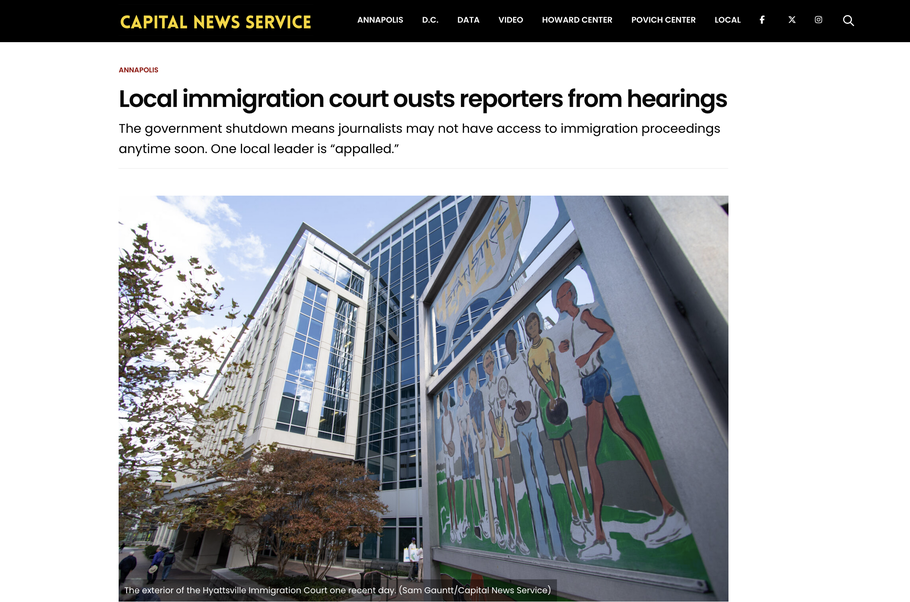Incident details
- Date of incident
- October 28, 2025
- Location
- Hyattsville, Maryland
- Government agency or public official involved
- Type of denial
- Change in policy or practice
Denial of Access

The Capital News Service, a student-run outlet at the University of Maryland, reported that two of its journalists were removed from the Hyattsville Immigration Court on Oct. 28, 2025, and told they couldn’t return without the proper permissions.
Student journalists Lillian Glaros and Ruby Siefken were ordered out of an immigration court in Hyattsville, Maryland, on Oct. 28, 2025, and told they couldn’t return until they obtained the correct permissions.
Glaros and Siefken, reporters for the Capital News Service, a student-run publication out of the University of Maryland in College Park, were ultimately allowed to come back a week later.
Siefken told the Tracker that they arrived at the courthouse at approximately 8:30 a.m. As in previous visits, they passed through the standard security measures at the front door and went directly to the part of the building where the Hyattsville Immigration Court is housed.
“We checked out the docket for the day, and we were really just looking to see if there were any available master cases for us to sit in on and observe,” Siefken said, referring to the first hearing in the removal process when multiple individuals are informed of the charges against them and their rights.
The pair ultimately entered Judge Dinesh Verma’s courtroom during a transition between two asylum-related cases.
“We were seated for about 15 or 20 seconds before Judge Verma addressed us directly and said, ‘Are you all here to participate in a hearing or just to observe?’ To which I responded, ‘We are just here to observe,’” Siefken said. “He then questioned further and said, ‘Are you all law students? Are you lawyers? Are you members of the media? What exactly is bringing you here today?’”
When Siefken said they were journalists there to report for an article, Verma asked if they had checked in with a public affairs officer at the front desk, to which they replied no, as they weren’t aware that was expected or required.
Verma then referred them to his legal assistant Tiffany Baker, and said she would escort them to the public affairs officer “to make sure that you have all of the proper press permissions to be media members in the courtroom,” Siefken told the Tracker.
There, they were informed that they needed permission from an official with the Department of Justice. Each time they attempted to call the number provided, they connected with an automated response. And when they pressed the button to identify as members of the media, the line would go dead.
The two then tried emailing two addresses they were provided, but both came back with automated responses, Siefken said.
One was from Kathryn Mattingly, the DOJ representative tied to the Hyattsville courthouse. “That exact message read: ‘The appropriation that funds my salary lapsed, and as a result I have been furloughed and I’m currently out of the office,’” Siefken recounted.
“Lillian and I start to realize that there was no way for us to actually get in touch with this person that would be able to give us the correct press permission to enter back into the courthouse that day, let alone any time in the future,” she added.
The journalists pursued other avenues — calling the courthouse and a court administrator, and reaching back out to Baker. Each told them that there was no other person who could authorize their entry.
“That is when we decided to go ahead and write this story and move to publication,” Siefken said, referencing their co-authored article, “so that the general public was aware of the fact that media was not being accurately represented in immigration courthouses, at least this specific immigration courthouse.”
Glaros told the Tracker that she and Siefken, as well as a third CNS reporter, had observed proceedings in the immigration court in September and October without issue. She added that she had even sat in Verma’s courtroom, and had always complied with judges’ requests and identified herself as a journalist when asked.
The ejection drew national attention and condemnation from alumni and press freedom advocates — including Freedom of the Press Foundation, of which the Tracker is a project.
Then, on Oct. 31, the DOJ’s Executive Office for Immigration Review emailed the journalists informing them that “immigration court hearings are generally open to the public.”
Siefken said they printed out a copy of the letter and brought it with them to the immigration court Nov. 4, in case they received any pushback.
“We actually went back to Judge Verma’s courtroom and were able to observe without issue,” she told the Tracker.
She added that as a student journalist, this was her first experience facing restrictions on her journalistic work and that she hadn’t seen any other reporters attempting to cover these hearings.
“This is something that is so relevant and pertinent to the public right now,” Siefken said. “This just drove home how important our reporting is, and CNS will continue to provide this coverage.”
In November, the DOJ issued a new fact sheet on observing immigration court hearings, updating the language to say that members of the media are “encouraged” to coordinate visits with the Executive Office for Immigration Review’s Office of Policy and identify themselves to front desk staff upon arrival.
The U.S. Press Freedom Tracker catalogs press freedom violations in the United States. Email tips to [email protected].